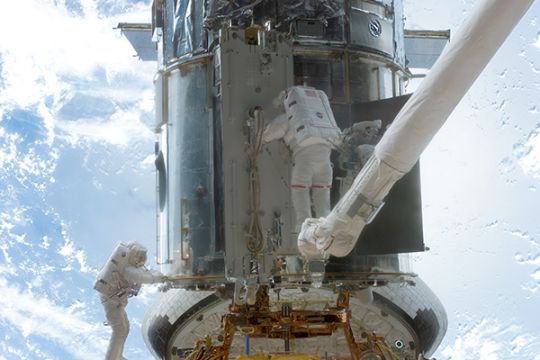The Hubble Space Telescope servicing mission is one of the most planned missions known to NASA. At the Goddard Center in Maryland, where telescope supervisors and the Shuttle Control Center in Houston are preparing to oversee the complex mission that is expected to launch on May 12

Galaxies from the early universe. The baby house of the planets, dark matter, dark energy. Since its launch in 1990, the Hubble Space Telescope has brought the mysteries of the universe into focus. His penetrating gaze scans the universe for details that ground-based telescopes, however sophisticated, are difficult to detect.
Far above the Earth's surface, the Hubble Space Telescope hovers above the atmosphere that reflects and scatters light, and it transmits images that paralyzed humanity and changed the scientific world. Hubble's victory continues to accrue thanks to a unique design that allows astronauts to repair and upgrade the telescope while in orbit. The repairs maintain the smooth functioning of the telescope and the upgrades of the observation instruments allow the continued progress of discoveries and science.
On May 12, 2009, after a delay from the original planned date (October 8, 2008), astronauts will board Space Shuttle Atlantis for Upgrade Mission #4 (SM4), the final journey for the Hubble Space Telescope. During five spacewalks, they will install two new instruments, repair two others that broke down, and replace components that will keep the telescope functioning until at least 2014. The strenuous, meticulous mission will also involve different groups of people on the ground all over the United States.
To places, high school, go out
The mission is planned years in advance, and its success will be the product of months of intensive preparations and hard work by thousands of people at NASA, academia and industry. The astronauts trained at the Johnson Space Center in Houston, where they learned to deal with weightlessness in the huge water tank, and at the Goddard Space Flight Center in Maryland, where they entered the huge clean room to work on the actual equipment they would use to install on the Hubble. At Goddard they prepared the test instruments and hardware, while at the Kennedy Space Center in Florida they prepared the space shuttle for the mission.
During the fourth upgrade mission, crews at Johnson and Goddard sat around the clock to ensure mission success. The control center in Houston will monitor the space shuttle and the astronauts and supervise the spacewalks, the processes, the activities of the crew members and their health, as well as the shuttle systems and the experiments. Hubble personnel including managers, scientists and engineers from the Goddard Center and the Space Telescope Science Institute in Maryland will be split between mission supporters at Johnson and those who will work at Goddard.
At the Goddard Center, where the Hubble program is managed, and where the control center of the space telescope that controls the telescope itself is located, those responsible sent orders to prepare the telescope for the engineers' activities and they are preparing for an initial test of the new equipment. The control center ordered the telescope to close the doors to protect the delicate optics of the telescope and it will maneuver the Hubble into the position that the space station will reach.
When the shuttle gets within 60 meters of the Hubble, the control center orders Goddard to make a turn that will bring it into a position where the shuttle can pick it up. The astronauts will use the shuttle's robotic arm to capture Hubble and dock it into the shuttle's cargo deck.
In the next step, the astronauts will begin a series of five spacewalks lasting an average of six and a half hours each. Two astronauts will work outside the Hubble at the same time. One will handle tasks that require free levitation while the other will be connected by leg restraints to the robotic arm that will be operated by a third astronaut inside the shuttle. To guard against unintentionally drifting away, the astronauts will tie a safety belt to a cable that will stretch the length of the cargo deck. The Hubble itself is embedded with handles that will make it easier for the astronauts to hold on to it.

7 תגובות
The previous user was me
point,
Where do you get these pearls of wisdom in the wee hours of the night? I am surprised again every time 🙂
Nowadays it is not possible to discover new things in physics with equipment that costs less than a few million dollars.